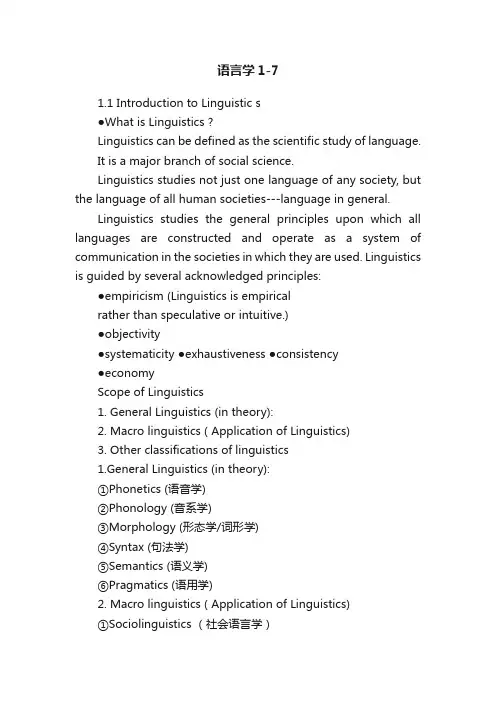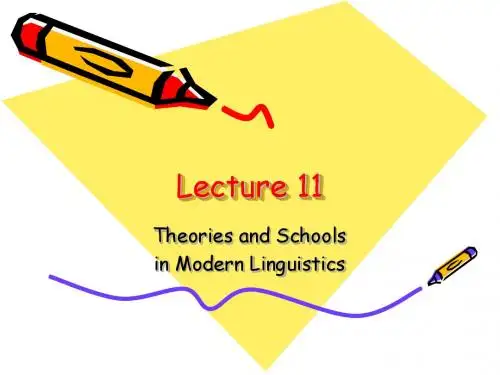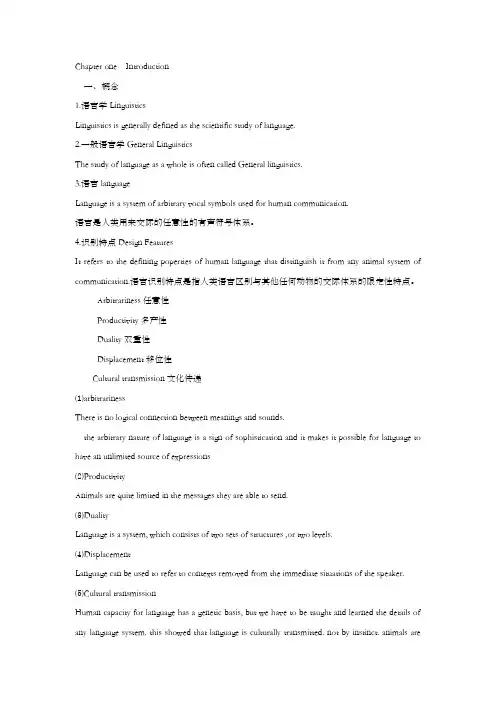linguistic schol--saussure
胡壮麟《语言学教程》测试题及答案

胡壮麟《语言学教程》(修订版)测试题第一章:语言学导论I. Choose the best answer。
(20%)1. Language is a system of arbitrary vocal symbols used for human __________.A. contact B。
communicationC. relation D。
community2。
Which of the following words is entirely arbitrary?A。
tree B. typewriterC。
crash D。
bang3。
The function of the sentence “Water boils at 100 degrees Centigrade.” is __________.A. interrogativeB. directiveC. informativeD. performative4。
In Chinese when someone breaks a bowl or a plate the host or the people present are likely to say“碎碎(岁岁)平安”as a means of controlling the forces which they believes feel might affect their lives. Which functions does it perform?A。
Interpersonal B. EmotiveC. Performative D。
Recreational5。
Which of the following property of language enables language users to overcome the barriers caused by time and place,due to this feature of language, speakers of a language are free to talk about anything in any situation?A。
Saussure

Ferdinand de Saussure (1857-1913) was a Swiss linguist who occupies an important place in the history of linguistics. He was the pivotal figure in the transition from the 19th to 20th century, and is generally considered the founder of modern linguistics. Saussure was a classmate of Brugmann and Leskien, and an important figure in the young grammarians. He published a few highly respected papers, but his more influential work was published after his death. His students at the University of Geneva were so impressed by his lectures that they thought his ideas concerning linguistic questions were original and insightful and should be preserved. So his students collected and edited their notes and published his Courses in General Linguistic (Cours de Linguistique Generale) in 1916, three years after his death. That is to say, this book is a collection and expansion of notes taken by Saussure's students during various lecture courses that he gave. Understandablely, it is rather fragmentary in character, and in many places there are hints only in the theoretical position which subsequent exegesis has concluded and Saussure must have held. There is also very little in the way of detailed illustration of his views. But its influence has been unparalleled in European linguistics since then, and it has had a major formative role to play in the shaping of linguistic thought in Europe over the thirty years or so which followed its publication. This book became the most important source of Saussure's ideas and of his influence upon succeeding generations of linguists.Few other figures in the history of the science of language have commanded such lasting respect and inspired such varied accomplishments as Ferdinand de Saussure. Leonard Bloomfield justly credited the eminent Swiss professor with providing “ a theoretic foundation to the newer trend in linguistics study," and European scholars have seldom failed to consider his views when dealing with any theoretical problem. Jonathan Culler (1976) says, “Ferdinand de Saussure is the father of modern linguistics, the man who reorganized the systematic study of language and language in such a way as to make possible the achievements of twentieth-century linguists. This alone would make him a Modern Master: master of a discipline which he made modern."De Saussure was responsible for three key directions in the study of language. First, he broke with the young grammarians by pointing the distinction between historical linguistics and the state of language at any point in time. He was determined to delimit and define the boundaries of languge study. To this end he began by distinguishing between historical linguistics and descriptive linguistics, or diachronic and synchronic analyses respectively. The distinction was one that comparative philologists had often confused, but for Saussure landing, subsequently for linguistics it was essential. Synchronic linguistics sees language as a living whole, existing as a “state" at a particular point in time. It is descriptive linguistics that concerns with the state of a languge at any point in time, especially the present. Once linguist has isolated a focus—point forsynchronic description, the time factor becomes irrelevant. Whatever changes may be taking place in their material, they are considered trivial. To consider historical material is to enter the domain of diachronic linguistics. It is the study of language history and change. This was the type of work that characterized most of Saussure's predecessors because the crucial question about language, at least until the 19th century, revolved around discovering the origin of language. Diachronic linguistics deals with the evolution of a language through time, as a continually changing medium—a never-ending succession of language states. Thus we may wish to study the change from Old English to Middle English, or the way in which Shakespeare's style changed from youth to maturity: both would be examples of diachronic study. Saussure drew the inter-relationship of the two dimensions in the way:Here AB is the synchronic “axis of simultaneities"; CD is the diachronic “axis of successions". AB is a language state at an arbitrarily chosen point in time on the line CD (at X); CD is the historical path the language has traveled, and the route, which it is going to continue traveling.This distinction is significant because synchronic analyses were either ignored or overlooked in the past, and most importantly, the distinction drew attention to the current structural properties of language as well as historical dimensions. Language system is complete and operates as a logical system or any point in time regardless of influence from the past. A language has an existence separate from its history. People who speak it constitute the language at any point in time and, of course, they are ignorant of its history.This led to de Saussure's second contribution; the distinction between language and parole. Language is such a complex and varied phenomenon that it would be impossible to study it without assuming some basic operating principles. Saussure made a distinction among three main senses of language, and then concentrated on two of them. He envisaged language (human speech as a whole) to be composed of two aspects, which are called langue (the language system) and parole (the act of speaking). Langue was considered by Saussure to be the totality of a language, deducible from an examination of the memories of all the language users. Langue, then, is an abstract system that all of us have in common and enables us to speak. It is the cognitive apparatus that members of a community share that allows them to use the vocabulary, grammar, and phonology in order to actualize speech. Langue is what the individual assimilates when he learns a language; it exists in the mind of each speaker. “It is the social product whose existence permits the individual to exercise his linguistic faculty." It is certainly a mentalistic concept of language system. Saussure argued strongly that the characteristics of langue were really present in the brain, and not simply abstractions. Langue is also something which the individual speaker can make use of but cannot be affected by himself; it is a corporate, social phenomenon. Parole, on the other hand, is the “executive side of language." Parole, is the actualization of langue. It is the way we actually speak---the vocabulary, accent, and syntactic forms. That is to say, it is the actual, concrete act of speaking on the part of an individual, the controlled psychophysical activity, which is what we hear. It is a personal, dynamic and social activity, which exists at a particular time and place and in a particular situation, as opposed to langue, which exists apart from any particular manifestation in speech.The distinction between Langue and parole is important. In distinguishing them, we are separating what is social from what is individual, and what is essential from what is accidental. If we study the phenomenon of speech we will find so many things, which are relevant to our study and the work will end up in confusion. If we concentrate on langue, then every aspect of language and speech fall into place within it. The distinction between langue and parole also has important implications for other disciplines as well. It is essential for any field of research to distinguish what belongs to the underlying system which makes possible various types of behavior and what belongs to actual instances of such behavior.Saussure's third main theoretical contribution was to clarify the concept of a language system and many linguists feel that it was this facet of his thought that had the most profound influence on subsequent scholarship. He completed his tenets of structuralism. He showed that the principles of langue must be described synchronically as a system of elements composed of lexical,grammatical, and phonological components. The terminology of linguistics was to be considered relative to each other. In other words, an element of the linguistic system is meaningful only in relation to other elements. The most immediate and significant impact of de Saussure's structural theory was in the area of phonology. It ledto the concept of the phoneme as a distinct and indivisible sound of a language. Although de Saussure's structuralism was crucial to the development of phonology, he was really interested in the larger and more abstract “system of signs." Linguistics was really the study of signs and their relationships. De Saussure characterized signs as a relationship between “concept" and “sound" to use de Saussure's words signified and signifier. Saussure called this relationship of signified to signifier a linguistic sign. The sign, for him, is the basic unit of communication, a unit within the langue of the community. Being a relationship, and part of langue, it is thus a mental construct but we must remember that Saussure considered such constructs as nonetheless real (he refers to the sign as a ‘concrete entity,' at one point). Langue, in this way, can be viewed as a system of signs. The linguistic sign is constituted by the structural rel ationship between the concept (e.g., “house"---the signified) and the sound of the word “house" (signifier). A language is essentially composed of such structural relationships, and the study of language is the study of the system of signs that express ide as. “Language," said de Saussure, “is a system of inner-dependent terms in which the value of each term results solely from the simultaneous presence of the others" (de Saussure, 1959, p.114).Two types of structural relationship in a language system presented by de Saussure are syntagmatic and associative. Syntagmatic relationships of a word are those relationships that can obtain with neighboring in a sentence. Associative structural relations pertain to the ways in which words can replace one another, and the ways in which they do not. These relationships are about how words and sounds are associated with each other and form part of the synchronic relationship within the language structure.The influence de Saussure had on language was revolutionary. His work had a profound influence on many aspects of linguistics but synchronic analysis is one of the most radical because it turned language on itself. He argued that language was a closed and self-defining system, and his work caused linguists and scholars of language to look “inward" toward the internal mechanisms of language rather than “outward" to an empirical world. Language was structure-not function; it was form-not substance. The rewards of structuralism are significant. His theorizing led to the phonology of Jakobson (1962) and the generative syntax of Chomsky (1957). And his semiotics or “science of signs" had made great headway in understanding verbal and nonverbal modes of communication: images, musical sounds, rituals, and social conventions all constitute fascinating systems of meanings. Saussure was the intellectual impetus for relegation language to the realm of internal logic and structural mechanisms that had little concern for the vicissitudes of language in context, or of how people actually use language to accomplish social goals.References[1]Ellis, Donald G. (1992). From language to communication. Lawrence Erlbaum Associates, Publishers.[2]Lrystal, David. (1985). Linguistics. New York : Viking Penguin Inc.[3]Hu Zhuanglin & Runqing Liu. (1989). Linguistics: A Course Book. Beijing: Peking University Press.[4]Saussure , Ferdinand de. (1960). Course in General Linguistics. Beijing: China Social Science Publishing House.。
Topic 3 西方翻译理论简介

Topic 3 The Development of Theories in the WestI.The beginning period – the end of 4th century B.CBackground: Roman Empire became powerful in the world. Greek culture was very attractive to Rome. Representatives:Andronicus: Home’s Odysseus, 240 B.CThe first large-scale translation activity in Europe.Cicero: The first translation theorist in the west in Roman period literal translation and free translation from the view of a rhetor and orator.Weakness: lake of systematic study of translation principle.Significance: ①introduce the ancient Greek literature into Rome even into the western world. ②develop Rome literature.II.From Rome Empire to early Middle AgesBackground: to meet the needs of Christian community-develop the religious culture, Scriptures was translated form Hebrew to Latin.Features: religious translation activityRepresentatives: Jerome, the Old TestamentThe most systematic among all ancient translators意译:Free translation-literary works直译:Literal translation-the scripturesIII.The Medieval TimesTranslation center form Baghdad (Syria) to Toledo (Spain)①Syria: the 9th -10th century, founded the House of Wisdom, Greek-ArabicFeatures: word-for-word translation②Toledo: the 11th– 12th century the school to Toledo Arabic→Latin and SpainSignificance: to provide a solid scientific and technological basis for the European Renaissance.IV.The Renaissance PeriodFeatures: from ancient literary works to major contemporary worksRepresentative:Martin Luther New Testament into German①shifts of word order②use of modal auxiliaries③introduce of connectives④suppression of foreign terms that had no equivalent in German⑤use phrase in target language to translate words in source language⑥shifts of metaphor to non-metaphor or vice verse.V.From the late of 17th century to the early of 20th centuryRepresentative: John Dryden, Alexander Tytler, Arnold NewmanFeature: to cultivate a literary nature; to advance the theory of translatability and untranslatability.VI.Contemporary translation studies world war ⅡFeatures:①progress in different field②a special occupation③including modern translation theories (1959-1972) and contemporary translation theories (1972-nowadays)Modern translation theories (1959-1972)Representative:1. Roman Jakobson: On Linguistic Aspect of Translation in 1959 intralingual translation. Interlingual Translation, Intersemiotic translation.2. J. R. Firth & Catford: the theory of textual equivalence3.Eugene NidaContemporary Translation theories (1972-now)Representative: James HolmesThe Name and Nature of Translation studies in 1972 proposed that Translation Studies is an independent subject. Including: Deconstruction School, Post-colonialism and Feminism school.VII. Schools of Translation:I. Philological SchoolTime: before the world warⅡBackground:from translators’ translation practiceFeatures: Literal and free translation; content and style; faithfulness and aestheticsWeakness: no systematic translation theoriesResearch objects:1)Register 2) figures of speech 3)creativity of language1) Register: The relationship between a particular style of language and its context of use①Diachronic perspective: to observe adaptability of language from history development: neologism; archaism; old-fashioned word; old use②Synchronic perspective: to analyze language usage from synchronic sequence; terminology; written language, oral language, common language, vulgarity, etc③Interlacing perspective Function: whether translation is in accordance with ST on linguistic level and whether it reflects the character, time, and individual style of the work.2) Figure of speechComparison on figure of speech between ST and TT: to find the hidden rules and establish regulation or criterion to guide translation and its evaluation.Three approaches to conform to criteria:①Domestication: Venuti,1995 译者向目的语者靠拢②Foreignization 向原语文化靠拢,把原语言中的文化信息向目的语转输丰富目的语。
语言学1-7

语言学1-71.1 Introduction to Linguistic s●What is Linguistics ?Linguistics can be defined as the scientific study of language.It is a major branch of social science.Linguistics studies not just one language of any society, but the language of all human societies---language in general.Linguistics studies the general principles upon which all languages are constructed and operate as a system of communication in the societies in which they are used. Linguistics is guided by several acknowledged principles:●empiricism (Linguistics is empiricalrather than speculative or intuitive.)●objectivity●systematicity ●exhaustiveness ●consistency●economyScope of Linguistics1. General Linguistics (in theory):2. Macro linguistics ( Application of Linguistics)3. Other classifications of linguistics1.General Linguistics (in theory):①Phonetics (语音学)②Phonology (音系学)③Morphology (形态学/词形学)④Syntax (句法学)⑤Semantics (语义学)⑥Pragmatics (语用学)2. Macro linguistics ( Application of Linguistics)①Sociolinguistics (社会语言学)②Psycholinguistics (心理语言学)③Corpus linguistics (语料库语言学)④Computational linguistics (计算语言学)⑤Stylistic linguistics (stylistics) (文体学/语体学)⑥Applied linguistics (应用语言学)⑦……3. Other Classifications of Linguistics (linguistic schools)①Functional linguistics (功能语言学)②Structural linguistics (结构语言学)③Chomskyan linguistics (乔姆斯基语言学)④Hallidayan linguistics(韩礼德语言学)⑤……History of Linguistics5th century BC, Ancient Greeks began to study languageAncient (Plato), word origin & word class of Greek15th century, universal grammar(Europe encountered other languages which forced scholars to look for a universal grammar.)18th century, the similarities of some languages(1786, Sir William Jones , the historical kinship of Sanskrit with Lain, Greek and the Germanic languages.)19th century, historical comparison of different languages early 20th century, modern linguistics(1916, F. de Saussure, Course in General linguistics)The historical development of linguistics●-Philology (语文学)( 5th cen BC—18th cen)●-Historical (comparative) linguistics (early 19th cen)●-Modern (synchronic)linguistics (1916---)(Course in General Linguistics, Ferdinand de. Saussure)F. de Saussure (1857-1913) 索绪尔Biography●1857年生于瑞士日内瓦的一个学者家庭。
Lecture 11

Saussure’s ideas on language
• Saussure believed that language is a system of signs. To communicate ideas, they must be part of a system of conventions, part of a system of signs. This sign is the union of a form and an idea, which Saussure called the signifier and the signified. Some important distinctions Saussure made in linguistics include langue vs. parole, syntagmatic vs. paradigmatic, and synchronic vs. diachronic.
Important concepts
• Theme – the point of departure of a sentence, which is equally present to the speaker and hearer; • Rheme -- the goal of discourse which presents the very information that is to be imparted to the hearer; • Known/ given information -- information that is not new to the reader or hearer; • New information -- what is to be transmitted to the reader or hearer.
语言学Linguistics笔记

Chapter one Introduction一、概念1.语言学LinguisticsLinguistics is generally defined as the scientific study of language.2.一般语言学General LinguisticsThe study of language as a whole is often called General linguistics.3.语言languageLanguage is a system of arbitrary vocal symbols used for human communication.语言是人类用来交际的任意性的有声符号体系。
4.识别特点Design FeaturesIt refers to the defining poperties of human language that distinguish it from any animal system of communication.语言识别特点是指人类语言区别与其他任何动物的交际体系的限定性特点。
Arbitrariness任意性Productivity多产性Duality双重性Displacement移位性Cultural transmission文化传递⑴arbitrarinessThere is no logical connection between meanings and sounds.the arbitrary nature of language is a sign of sophistication and it makes it possible for language to have an unlimited source of expressions⑵ProductivityAnimals are quite limited in the messages they are able to send.⑶DualityLanguage is a system, which consists of two sets of structures ,or two levels.⑷DisplacementLanguage can be used to refer to contexts removed from the immediate situations of the speaker.⑸Cultural transmissionHuman capacity for language has a genetic basis, but we have to be taught and learned the details of any language system. this showed that language is culturally transmitted. not by instinct. animals areborn with the capacity to produce the set of calls peculiar to their species.5.语言能力CompetenceCompetence is the ideal user’s knowledge of the rules of his language.6.语言运用performancePerformance is the actual realization of this knowledge in linguistic communication.语言运用是所把握的规那么在语言交际中的表现。
英语语言学-语言学知识点
定义:language is passed on from generation to generation through teaching and learning rather than instinct.
Cultural Transmission(文化传递性):
3. Design feature 定义特征
语言学知识点
CLICK HERE TO ADD A TITLE
单击此处添加文本具体内容
演讲人姓名
01
02
03
I 语言学导论
II 语言学主要分支学科
III 语言学的流派和理论
design feature of language (语言的定义特征) Language Families (世界语言分类) important distinctions in linguistics (语言学研究中几对重要的概念) scope of linguistics (语言学的研究范围)
Arbitrariness(任意性)
01
Duality(二层性)
02
Creativity/Productivity(创造性)
03
Displacement(移位性)
04
Cultural Transmission(文化传递性)
05
1)Arbitrariness(任意性): 定义:the forms of linguistic signs bear no natural relationship to their meaning. 举例: 书, book, livre 喜欢,like,aimer
Duality(二层性):
定义:the property of having two levels of structures, such that units of the primary level are composed of elements of the secondary level.
Saussure终极版解析上课讲义
❖ In Saussure’s view, language is a system of signs, each of which consists of two parts: Signified(所指/受指), stands for concept; Signifier(能指/施指), stands for sound image.
❖ One form of language can mean differently in different contexts.
❖ The same meaning can be expressed in different linguistic forms.
Arbitrariness & Onomatopoetic(拟声) dimension
❖ The signifier is now commonly interpreted as the material (or physical) form of the sign - it is something which can be seen, heard, touched, smelt or tasted. For Saussure, both the signifier and the signified were purely 'psychological' . A sound pattern is the hearer's psychological impression of a sound, as given to him by the evidence of his senses. The other element is generally of a more abstract kind: the concept.
linguistics
Chapter one Linguistics1. Definition of linguistics: the scientific study of language.讲:Linguistics deals with the complicated system of language and the rules operating in it. The purpose of studying linguistics is to examine the body of facts that and to make general statements about its various elements that relate to regular rules.Linguistics tries to tell people "what language is ", "how language originates, changes and develops ", "what common characteristics that all language share ", "how language works in human communication" and many other facts about language.The founder of general linguistics: F.de Saussure, established modern linguistics as an independent science.2. Scope of linguistics (陈)2.1 In the study of intralinguistic relationships among different linguistic elements:phnetics语音学,phonology音位学,morphology形态学, syntax句法学, semantics. (These branches fall into the scope of general linguistics: the study of language in relation to other sciences.)2.1 In the study of extralinguistic relationships with the outside world:sociolinguistics, psycholinguistics, applied linguistics, neurolinguistics, mathematical linguistics, pragmatics胡:Main branches of linguistics1. Phonetics: is the study of speech sounds, it includes three main areas: articulatory phonetics, acoustic phonetics, and auditory phonetics.2. Phonology: studies the rules governing the structure, distribution, and sequencing of speech sounds and the shape of syllables.3. Morphology: studies the minimal units of meaning – morphemes and word-formation processes.4. Syntax: refers to the rules governing the way words are combined to form sentences in a language, or simply, the study of the formation of sentences.5. Semantics: examines how meaning is encoded in a language.6. Pragmatics: is the study of meaning in context.3. Approaches to languageDifferent approaches can be made in the study of language.3.1.1diachronic (or historical ) linguistics: 历时(在历史的过程中研究语言:纵向)If we make a study of language from its development in the course of time, it is termed~.3.1.2 synchronic linguistics. 共时(以固定的时间为观察角度:横向eg. 现代语言学)It is devoted to the description and analysis of a given linguistic status or stage of a particular language. 3.2. comparative linguistics.:It makes a comparative study of the similarities and differences among languages.3.3.1 descriptive linguistics (描写式): describes how a language is actually used.3.3.2 prescriptive linguistics (规定式): attempts to prescribe rules or principles for how people ought to use a lg. 辨析1) If the linguistic study aims to describe and analyze the language people actually use, it is said to be descriptive; If the linguistic study aims to lay down rules for "correct and standard" behavior in using language, i.e. To tell people what they should say and what they should not say, it is said to be prescriptive.2) For example, “Don’t say X.” is a prescriptive command; “People don’t say X.” is a descriptive statement.3) The distinction lies in prescribing how things ought to be and describing how things are. In the 18th century, all the main European languages were studied prescriptively. However, modern linguistics is mostly descriptive because the nature of linguistics as a science determines its preoccupation with description instead of prescription.4. GrammarDefinition: in a broad sense, is a science of the structure of a language and both the syntactic and semantic rules of its generally accepted use.4.1 descriptive grammar: describes basic linguistic knowledge, explains how a lg is actually spoken or written.(邓)4.2 prescriptive grammar: prescribes the rules or principles of the grammar.4.3 pedagogical grammar: is a grammatical description of a language specially designed as an aid to teaching that lg to native or foreign learners. It emphasizes the functional aspects of grammar. 教学语法4.4 universal grammar: usually credited to Noam Chomsky, is the study of the universal features of lg.The theory suggests that linguistic ability manifests itself without being taught, and that there are properties that all natural human languages share.通用语法(baidu)\5. Schools of linguistics5.1. The traditional grammar school: attempted to lay down universally valid rules to show how a language ought to be used. It is prescriptive rather than descriptive. (Traditional grammarians overstressed the importance of written lg and paid little attention to spoken lg.)5.2. Structuralist linguistics: refers to any linguistic study of a language which is taken as an independent system of sound, grammar and vocabulary in its own right. (It is a new approach to the analysis of language. It is descriptive) 5.3 The transformational-generative grammar school: developed by Noam Chomshy and his colleagues in the middle of 1950s, appears as a synthesis of most interesting contributions to the traditional and structural schools. It is regarded as a revolution in the study of language.Universal grammar: based on a hypothesis that there are universal properties shared by all human languages, has been proposed by Noam Chomshy and his colleagues. They believe the grammar of a language represents speakers, linguistic knowledge or competence, including the sounds and words and the rules for the pronunciation, formation and interpretation of sentences. Linguistic knowledge represented in the universal grammar is not taught in schools, but innate.The development of the T.G. Grammar: 5 periods /stages1. The first period(1957-1965): is characterized by the study of the syntactic structures of language2. 2nd (1965-1970): the Standard Theory3. 3rd ( 1970-1985): is marked by The Extended Standard Theory, in which Chomsky has revised some of his original basic notions and theories.4. 4th , Chomsky developed the Extended Standard Theory into the Revised Extended Standard Theory.5. GB period: the governing and binding theory (GBT), centers around problems in government and binding.。
Saussure
2) langue is a generally accepted way of communication. parole is simply a personal choice . 3) langue is relatively fixed and parole is temporary.
2.2: Synchronic and Diachronic
• ‘Synchrony is a fiction, for language changes as the minutes pass and grammar-writing is a lengthy enterprise. However, the fiction of synchronic description is essential of linguistics’ (Fowler)
2.1: Langue and Parole
a) Langue refers to the abstract linguistic system
shared by all the members of a speech community .
Parole refers to the realization of langue in actual use. b) The difference between langue and parole is obvious.
sound pattern. Langue without parole, can only express
very limited ideas. • In linguistics study, langue is the goal and parole is the tool. From the collection and analysis of parole, we could have an insight of the langue.
- 1、下载文档前请自行甄别文档内容的完整性,平台不提供额外的编辑、内容补充、找答案等附加服务。
- 2、"仅部分预览"的文档,不可在线预览部分如存在完整性等问题,可反馈申请退款(可完整预览的文档不适用该条件!)。
- 3、如文档侵犯您的权益,请联系客服反馈,我们会尽快为您处理(人工客服工作时间:9:00-18:30)。
speech
(parole) is heterogeneous(异质的,合成 的), that is to say composed of unrelated or differing parts or elements, language (langue) is homogeneous(同质的), composed of the union of meanings and 'sound images' in which both parts are psychological. Therefore, as langue is systematic, it is this that Saussure focuses on since it allows an investigative methodology that is rooted, supposedly, in pure science.
索绪尔1906-1907、1908-1909、1910-1911年在日内瓦大 学连续三次讲授普通语言学课程,但并没有写成书籍或讲义。 去世后,他的学生Charles Bally and Albert Sechehaye根据他三次讲授这门课程的听课笔记,参考 遗留的手稿,整理成《普通语言学教程》一书。 1916年《普通语言学教程》一书在日内瓦出第一版、1922 年在巴黎出第二版,其后还连续出了第三版和第四版,1949 年出第五版,各国语言学家先后把它译成德、西、俄、英、 日等国文字,使它的影响遍及全世界。中译本于1980年出版。 全书从序言到索引和目录,除“绪论”外,分为(一)一般 原则,(二)共时语言学,(三)历时语言学,(四)地理 语言学,(五)回顾语言学的问题等五部分。 《教程》是一部划时代的著作,对二十世纪的现代语言学研 究产生了深远的影响,重要内容有 : (1)区分语言和言语。 (2)区分共时和历时。(3)符号理论。(4)系统理论。 (5)符号学、音位学及其他。
In Saussure‘s view, language is a system of signs, each of which consists of two parts: Signified(所指/受指), stands for concept; Signifier(能指/施指), stands for sound image. The sign (signe) is described as a "double entity", made up of the signifier, or sound image, (signifiant), and the signified, or concept (signifié). 索绪尔最早指出,语言符号联系的不是事物和名称,“而是 概念和音响形象”; ―语言符号是一种有两面的心理实体”,他用“能指”和 “所指”这两个术语来分别指称符号的“两面”,并进一步 提出能指和所指之间的联系是不可分割的。 语言符号具有任意性和线条性的特点。
LANGUE & PAROLE
Langue语言: the linguistic competence of the speaker Parole言语: the actual phenomena or data of linguistics (utterances) langue, referring to the abstract system of language that is internalized by a given speech community parole, the individual acts of speech and the "putting into practice of language" 著名公式是:言语活动=语言+言语。 言语活动除去言语,剩下语言,这才是"语言学的又 完整又具体的对象”。
Arbitrariness & Onomatopoetic dimension
There are animal names derived from sounds the respective animal makes, but these forms did not have to be chosen for these meanings. Non-onomatopoetic words can stand just as easily for the same meaning. In time, onomatopoetic words can also change in form, losing their mimetic status. Onomatopoetic words may have an inherent relation to their referent, but this meaning is not inherent, thus they do not violate arbitrariness.
W. Humboldt
洪堡特(Baron von Wilhelmvon Humboldt, 1767 -1835),德国语言学家、语文学家和政治家。 1767年6月22日出生于德国波茨坦。 1787---1789: 法兰克福大学、哥廷根大学,学习哲学、政 治、法律以及考古学。 1809年他被任命为内务部文化和教育司的负责人,在此期 间他提议并创建了柏林大学。 1819年洪堡特离开了政界。 1820—1835:专心致力于语言研究。 1820年6月19日,他在柏林科学院宣读了他的论文《论与 语言发展的不同时期有关的比较语言研究》(简称《论比 较语言研究》),标志着他的语言和语言哲学研究工作的 开端。
3. 关于语言与思维
洪堡特把语言置于具体民族的文化背景之中,进一步考察 了语言在人们认识世界和处理事物的活动中所起的作用。 语言处在人与世界之间,人必须通过语言并使用语言来认 识世界。 他认为,每个民族都不可避免地会把某种独特的主观意识 带入自己的语言,从而在语言中形成一种特殊的“世界 观”。这种语言“世界观”反过来又可能制约着人们的非 语言行动。 在语言在多大程度上对思维产生影响这个问题上,洪堡特 更多地讨论了语言与思维的相互影响,而不是只讲语言对 思维的制约作用。 他明确指出,他要探讨的整个过程是“语言从精神出发, 再反作用于精神”
Linguistic Schools & Theories
W. Humboldt F. de Saussure Prague School Copenhagen School哥本哈根学派 American Descriptive Linguistics School Transformational-Generative Grammar Functional School & Systematic-Functional Schools Construction grammar
SIGNΒιβλιοθήκη theorySaussure believed that language is a system of signs that express ideas . Sounds count as language only when they serve to express or communicate ideas; otherwise they are nothing but noise. To communicate ideas, they must be part of a system of conventions, part of a system of signs. This sign is the union of a form and an idea---the SIGNIFIER and the SIGNIFIED.
4. 关于语言类型分类 洪堡特强调语言是一个“有机的整体”, 认为“结构性是一切语言最一般、最深刻 的特点” 他主张根据语言结构类型为语言分类。 他主要根据作为语法单位的词的占优势的 结构状况,把语言分为三种类型,即: 孤立型、粘着型和屈折型。 粘着这一术语就是他首先提出来的。
F. de Saussure
1828-1829年,他的名著《论人类语言结构的差 异》问世 1830-1835年他又精心写作了三卷巨著《论爪哇 岛上的卡维语》,该书的引言是一篇独立的论文, 题为《论人类语言结构的差异及其对人类精神发 展的影响》。 在这部著作中,洪堡特完整阐述了他的语言学思 想,使之成为他在该领域全部工作的总结。 洪堡特学识渊博、兴趣广泛,曾在美学、民族学、 古典文化等一系列领域进行过深入的探索,但他 一生的主要兴趣集中于语言的研究 他的语言研究在立足点,视野的广度和理论高度 上都超出同时代的语言学家,被视为理论语言学 和19世纪整个语言哲学系统的创始人。
2. 关于语言和民族的关系 非常强调语言与民族精神的联系,甚至提 出“语言仿佛是民族精神的外在表现;民 族的语言即民族的精神,民族的精神即民 族的语言”的论断。 语言是民族的最大特征,民族差异主要表 现在语言上; 一个民族的语言与该民族的精神特性密不 可分:语言随着民族的成长而发展,它是 民族精神的外在表现,同时它又承载着民 族的历史和文化。
ARBITRARINESS the forms of linguistic signs bears no natural relationship to their meanings.
There is no motivated relationship between the sign and what it is a sign for. The symbols have been chosen arbitrarily for the message. Illustrations: One form of language can mean differently in different contexts. The same meaning can be expressed in different linguistic forms.
